

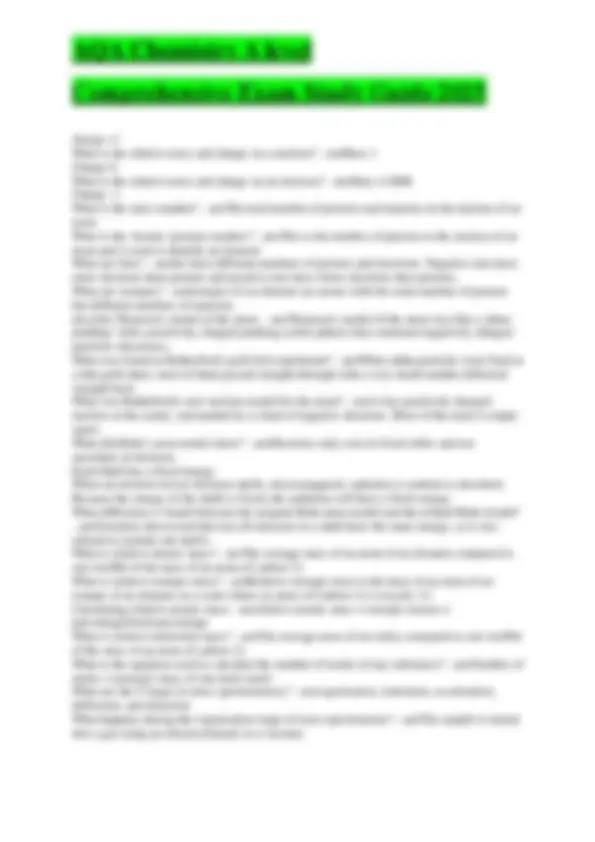
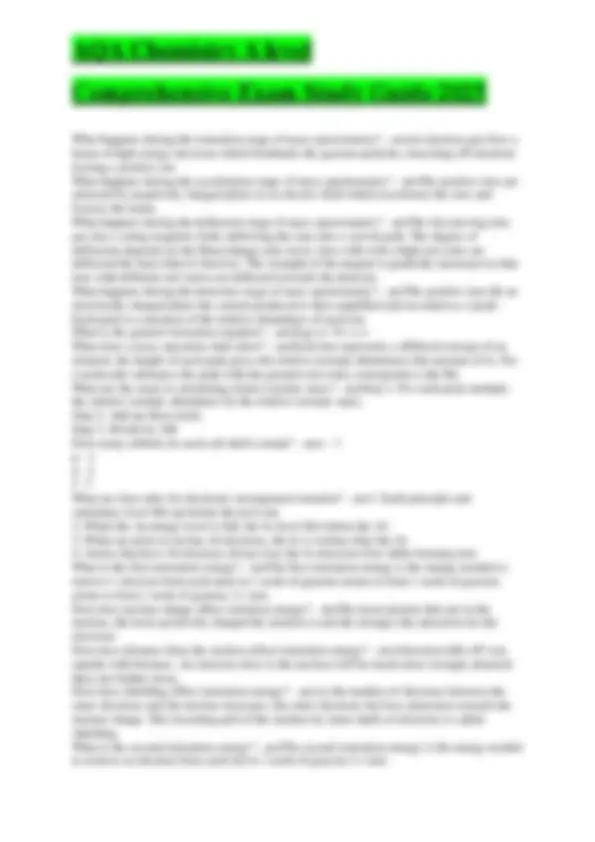
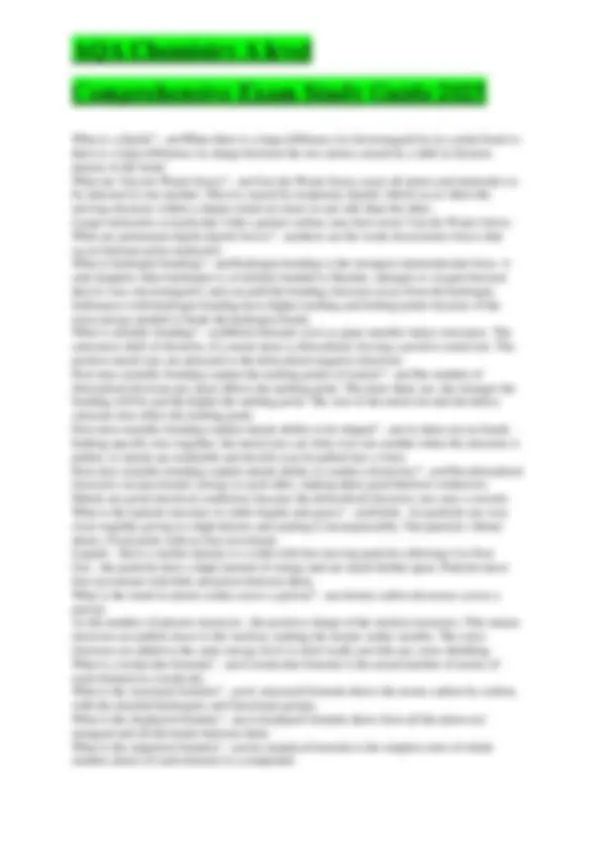
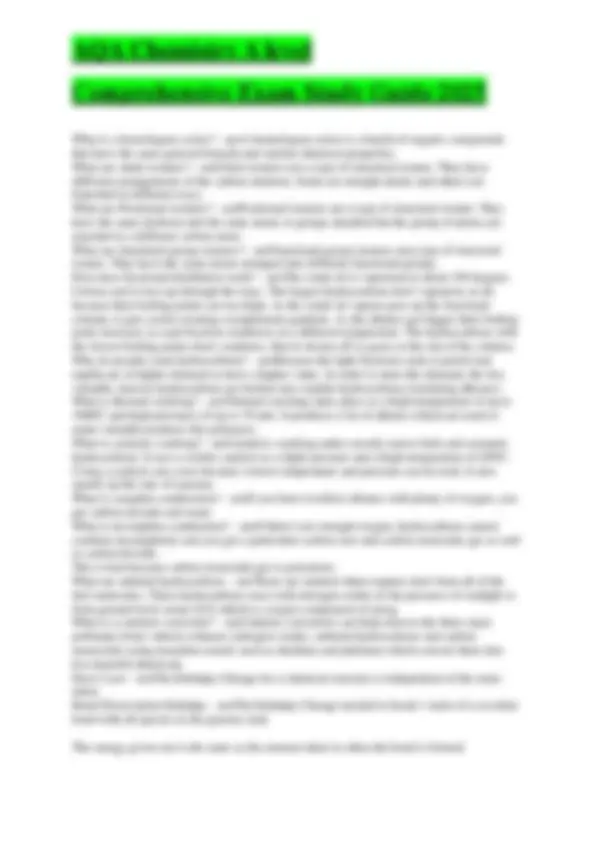
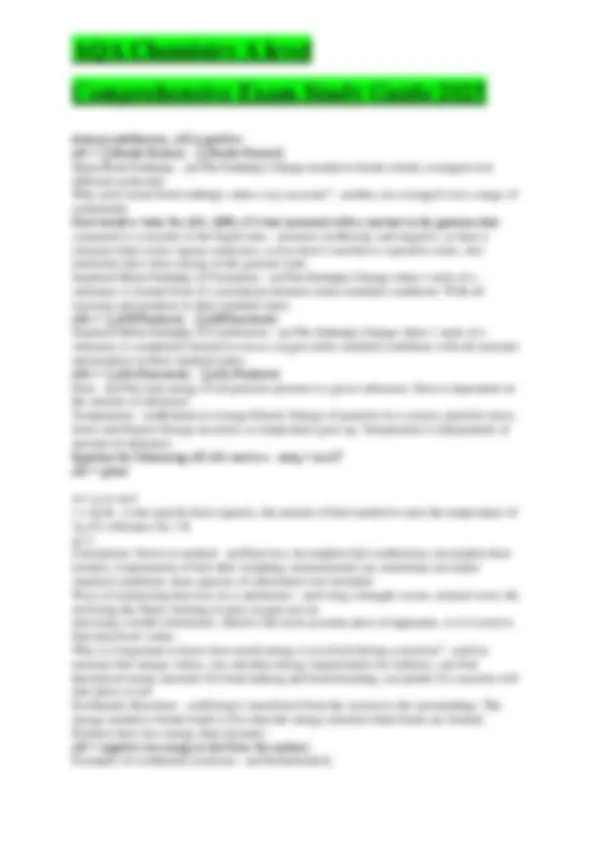

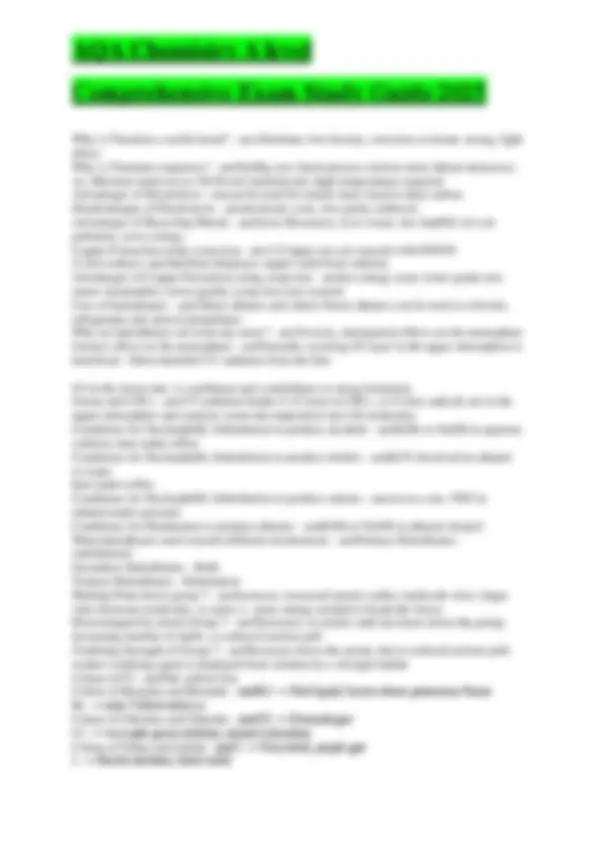
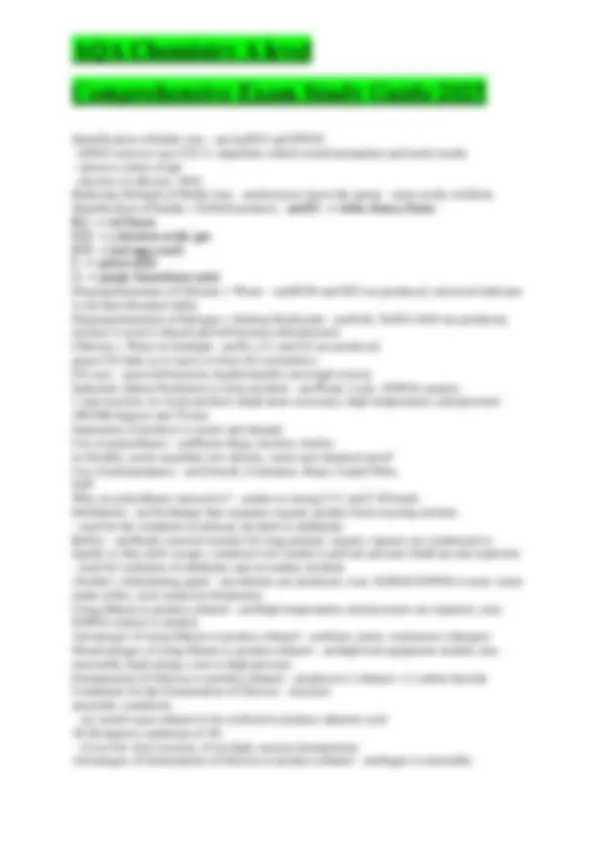

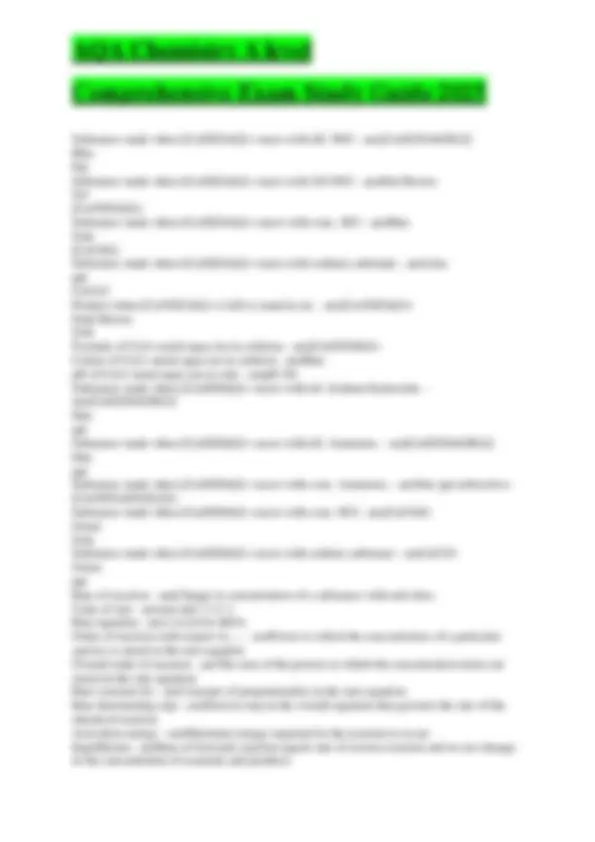
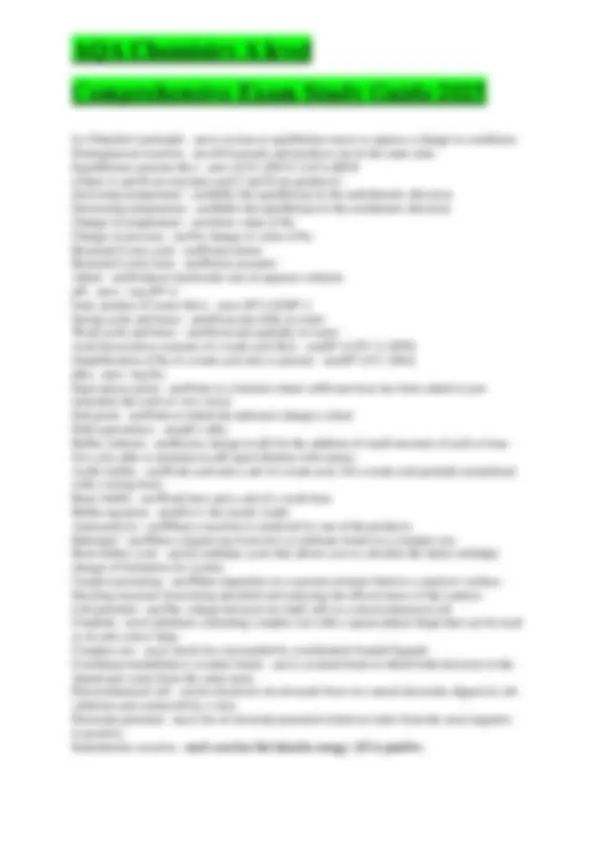
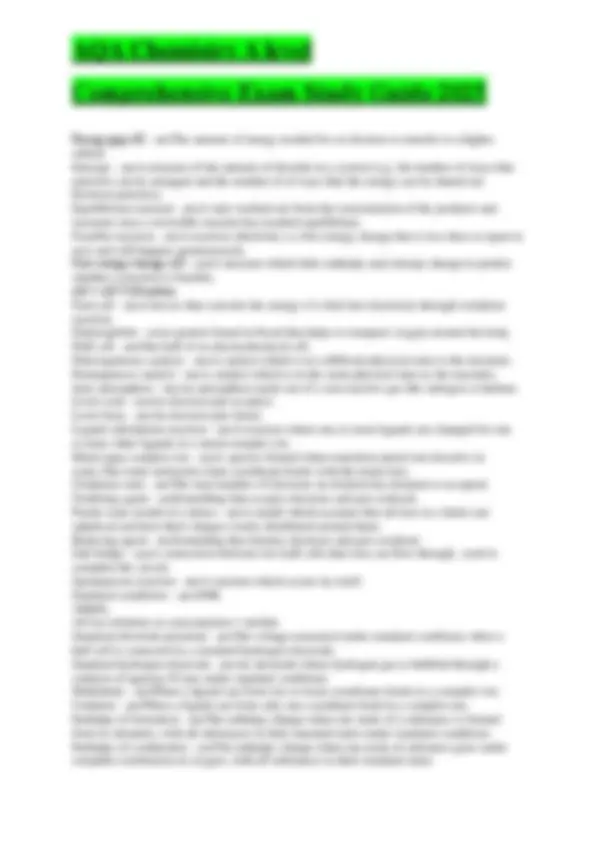
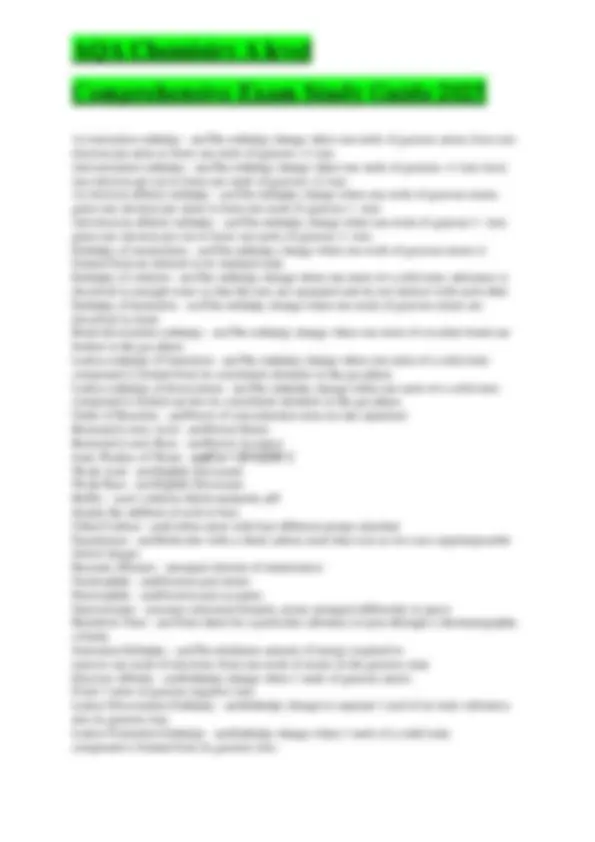



Study with the several resources on Docsity

Earn points by helping other students or get them with a premium plan


Prepare for your exams
Study with the several resources on Docsity

Earn points to download
Earn points by helping other students or get them with a premium plan
Community
Ask the community for help and clear up your study doubts
Discover the best universities in your country according to Docsity users
Free resources
Download our free guides on studying techniques, anxiety management strategies, and thesis advice from Docsity tutors
AQA Chemistry A Level 2025, transition metals, reaction mechanisms, ionisation energy, atomic structure, redox, organic chemistry, spectroscopy, equilibrium, enthalpy change, bonding models, catalysis, rate equations, exam definitions, chemistry formulas
Typology: Exams
1 / 23

This page cannot be seen from the preview
Don't miss anything!
















What makes transition metal characteristics - ansincomplete d sub-level in atoms or ions 4 main characteristics of Transition metals - anscomplex formation, formation of coloured ions, variable oxidation state, catalytic activity what is a complex - ansa central metal ion surrounded by ligands what is a ligand - ansAn atom, ion or molecule which can donate a lone electron pair what is a coordinate bond - ansCo-ordinate bonding is when the shared pair of electrons in the covalent bond come from only one of the bonding atoms what is coordination number - ansThe number of co-ordinate bonds formed to a central metal ion why is carbon monoxide toxic - ansCO is toxic to humans as CO can from a strong coordinate bond with haemoglobin. This is a stronger bond than that made with oxygen and so it replaces the oxygen attaching to the haemoglobin what is the chelate effect - ansThe substitution of monodentate ligand with a bidentate or a multidentate ligand leads to a more stable complex. This chelate effect can be explained in terms of a positive entropy change in these reactions as more molecules of products than reactants type of isomerism shown in square planar/octahedral complexes - ansE-Z isomerism shown only in octahedral complexes - ansComplexes with 3 bidentate ligands can form two optical isomers (non-superimposable mirror images) how do transition metals show colour - ansColour arises from electronic transitions from the ground state to excited states: between different d orbitals. A portion of visible light is absorbed to promote d electrons to higher energy levels. The light that is not absorbed is transmitted to give the substance colour. what is the equation which links the colour and frequency of the light absorbed with the energy difference between the split d orbitals - ansE = hv. v = frequency of light absorbed (unit s-1 or Hz) h= Planck's constant 6.63 × 10-34 (J s) E = energy difference between split orbitals (J) how can you change colour of transition metals - ansChanging a ligand or changing the coordination number will alter the energy split between the d- orbitals, changing E and hence change the frequency of light absorbed describe the method of spectroscopy - ans•Add an appropriate ligand to intensify colour •Make up solutions of known concentration (dilution series) •Measure absorption or transmission •Plot graph of absorption vs concentration •Measure absorption of unknown and compare general trend of variable oxidation states - ans- Relative stability of +2 state with respect to +3 state increases across the period
what is used to reduce vanadium - ansAddition of zinc to the vanadium (V) in acidic solution will reduce the vanadium down through each successive oxidation state, and the colour would successively change from yellow to blue to green to violet what is used in testing for aldehydes - ans[Ag(NH3)2]+ is used in Tollen's reagent to distinguish between aldehydes and ketones. Aldehydes reduce the silver in the Tollen's reagent to silver why are dark colours of solutions difficult to measure - ansThe purple colour of manganate can make it difficult to see the bottom of meniscus in the burette. what acid is used for manganate titrations - ansOnly use dilute sulphuric acid for manganate titrations. Insufficient volumes of sulphuric acid will mean the solution is not acidic enough and MnO will be produced instead of Mn2+. Using a weak acid like ethanoic acid would have the same effect as it cannot supply the large amount of hydrogen ions needed (8H+). It cannot be conc HCl as the Cl- ions would be oxidised to Cl what is a heterogenous catalyst - ansin a different phase from the reactants what is a homogenous catalyst - ansin the same phase as the reactants what are standard conditions for heterogenous catalysts - ansHeterogeneous catalysts are usually solids whereas the reactants are gaseous or in solution. The reaction occurs at the surface of the catalyst. how do heterogenous catalysts work - ansAdsorption of reactants at active sites on the surface may lead to catalytic action. The active site is the place where the reactants adsorb on to the surface of the catalyst. This can result in the bonds within the reactant moleculesbecomingweaker,or themoleculesbeingheldin a more reactive configuration. There will also be a higher concentration of reactants at the solid surface so leading to a higher collision frequency. how does the strength of adsorption help to determine the effectiveness of the catalytic activity. - ansSome metals e.g. W have too strong adsorption and so the products cannot be released. Some metals e.g. Ag have too weak adsorption, and the reactants do not adsorb in high enough concentration. what is the effect of increasing surface area - ansIncreasing the surface area of a solid catalyst will improve its effectiveness. A support medium is often used to maximise the surface area and minimise the cost (e.g. Rh on a ceramic support in catalytic converters). contact process equation (manufacture of sulphuric acid) - ansV2O5 is used as a catalyst in the Contact Process. Overall equation : 2SO2 + O2 --> 2SO3 step1 SO2 +V2O5 --> SO3 + V2O step 2 2V2O4 + O2 --> 2V2O what are the effects of catalytic poisoning - ansPoisoning has a cost implication e.g. poisoning by sulphur in the Haber Process and by lead in catalytic converters in cars means that catalysts lose their efficiency and may need to be replaced. reaction between iodide and persulphate ions - ansThe reaction between I- and S2O82- catalysed by Fe2+ The uncatalysed reaction is very slow because the reaction needs a collision between two negative ions. Repulsion between the ions is going to hinder this - meaning high activation energy.
charge + What is the relative mass and charge on a neutron? - ansMass 1 Charge 0 What is the relative mass and charge on an electron? - ansMass 1/ Charge - 1 What is the mass number? - ansThe total number of protons and neutrons in the nucleus of an atom What is the Atomic (proton) number? - ansThis is the number of protons in the nucleus of an atom and is used to identify an element What are Ions? - ansIon have different numbers of protons and electrons. Negative ions have more electrons than protons and positive ions have fewer electrons than protons. What are isotopes? - ansIsotopes of an element are atoms with the same number of protons but different numbers of neutrons describe Thomson's model of the atom. - ansThomson's model of the atom was like a 'plum pudding' with a positively charged pudding (solid sphere) that contained negatively charged particles (electrons). What was found in Rutherford's gold foil experiment? - ansWhen alpha particles were fired at a thin gold sheet, most of them passed straight through with a very small number deflected straight back. What was Rutherford's new nuclear model for the atom? - ansA tiny positively charged nucleus at the centre, surrounded by a cloud of negative electrons. Most of the atom is empty space. What did Bohr's atom model show? - ansElectrons only exist in fixed orbits and not anywhere in between. Each Shell has a fixed energy. When an electron moves between shells, electromagnetic radiation is emitted or absorbed. Because the energy of the shells is fixed, the radiation will have a fixed energy. What difference is found between the original Bohr atom model and the refined Bohr model?
What happens during the ionisation stage of mass spectrometry? - ansAn electron gun fires a beam of high energy electrons which bombards the gaseous particles, knocking off electrons leaving a positive ion What happens during the acceleration stage of mass spectrometry? - ansThe positive ions are attracted by negatively charged plates in an electric field which accelerates the ions and focuses the beam. What happens during the deflection stage of mass spectrometry? - ansThe fast moving ions pas into a string magnetic field, deflecting the ions into a curved path. The degree of deflection depends on the Mass/charge ratio (m/z). Ions with with a high m/z ratio are deflected the least (they're heavier). The strength of the magnet is gradually increased so that ions with different m/z ratios are deflected towards the detector. What happens during the detection stage of mass spectrometry? - ansThe positive ions hit an electrically charged plate/ the current produced is then amplified and recorded as a 'peak'. Each peak is a measure of the relative abundance of each ion. What is the general ionisation equation? - ansX(g) => X+ = e- What does a mass spectrum chart show? - ansEach line represents a different isotope of an element. the height of each peak gives the relative isotopic abundance (the amount of it). For a molecular substance the peak with the greatest m/z ratio corresponds to the Mr. What are the steps in calculating relative atomic mass? - ansStep 1: For each peak multiply the relative isotopic abundance by the relative isotopic mass. Step 2: Add up these totals. Step 3: Divide by 100 How many orbitals do each-sub shell contain? - anss - 1 p - 3 d - 5 f - 7 What are four rules for electronic arrangement notation? - ans1: Each principle and subsidiary level fills up before the next one 2: When the 3p energy level is full, the 4s level fills before the 3d 3: When an atom or ion has 3d electrons, the 4s is written after the 3d 4: Atoms that have 3d electrons always lose the 4s electrons first while forming ions What is the first ionisation energy? - ansThe first ionisation energy is the energy needed to remove 1 electron from each atom in 1 mole of gaseous atoms to form 1 mole of gaseous atoms to form 1 mole of gaseous 1+ ions. How does nuclear charge affect ioniation energy? - ansThe more protons that are in the nucleus, the more positively charged the nucleus is and the stronger the attraction for the electrons How does distance from the nucleus affect ionisation energy? - ansAttraction falls off very rapidly with distance. An electron close to the nucleus will be much more strongly attracted than one further away. How does shielding affect ionisation energy? - ansAs the number of electrons between the outer electrons and the nucleus increases, the outer electrons feel less attraction towards the nuclear charge. This lessening pull of the nucleus by inner shells of electrons is called shielding. What is the second ionisation energy? - ansThe second ionisation energy is the energy needed to remove an electron from each ion in 1 mole of gaseous 1+ ions.
are free to move and carry a charge. In a solid they're in a fixed position by the strong ionic bonds. What is the melting point for ionic compounds? - ansIonic compounds have high melting points. The giant ionic lattices are held together by strong electrostatic forces. It takes lots of energy to overcome these forces, so melting points are very high. What is the solubility of ionic compounds? - ansIonic compounds tend to dissolve in water. Water molecules are polar - part of the molecule has a small negative charge and the other bits have small positive charges. The water molecules pull the ions away from the lattice and cause it to dissolve. What is a covalent bond? - ansIn covalent bonding, two atoms share electrons, so they've both got full outer shells of electrons. Both the positive nuclei are attracted electrostatically to the shared electrons. What is the electrical conductivity like in a covalent bond? - ansSimple covalent compounds don't conduct electricity because there are no free ions to carry the charge. What is the melting point of a covalent bond? - ansSimple covalent bonds have low melting points because the weak forces between molecules are easily broken. What is the solubility of the covalent bonds like? - ansSome simple covalent compounds dissolve in water depending on how polarised the molecules are What are giant covalent structures - ansGiant covalent structures have huge networks of covalently bonded atoms. Carbon often forms this type of structure because they can each form four strong covalent bonds. What are the properties in Graphite? - ansGraphite has carbon atoms arranged in sheets of flat hexagons bonded with three bonds each. The fourth outer electron of each carbon is delocalised. The sheets of hexagons are bonded together by Van der Waals forces. Graphites weak bonds means that the layers can easily slide over one another, used in pencils and lubricants. It can also conduct electricity due to its delocalised electrons that are free to move along the sheets. It has a very high melting point due to the strong covalent bonds in the hexagon sheets. It is also insoluble. What are the properties of Diamond? - ansDiamonds carbon atoms are boned to four other carbon atoms. These are arranged in a tetrahedral shape. Diamond has a very high melting point and is very hard, it cannot conduct electricity due to all of its electrons being held in localised bonds. it can also not dissolve in a solvent. What is a dative covalent bond? - ansIn dative covalent, also known as co-ordinate bonding, one atom proved both of the shared electron in the bond. What is a lone pair? - ansAn unshared electron pair in a covalent bond. What is a charge cloud? - ansBonding pairs and lone pairs of electrons exist as charge clouds. A charge cloud is an area where you have a really big chance of finding an electron pair. What is electron pair repulsion theory? - ansElectrons are all negatively charged, so the charge clouds will repel each other as much as they can. The shape of the cloud charge affects how much it repels other charges. Lone pair charge clouds repel more than bonding- pair charge clouds. What is electronegativity? - ansThe ability to attract the bonding electrons in a covalent bond. It is meausred on the Pauling scale. The higher the number the better the ability to attract the bonding electrons.
What is a dipole? - ansWhen there is a large difference in electronegativity in a polar bond so there is a large difference in charge between the two atoms caused by a shift in electron density in the bond. What are Van der Waals forces? - ansVan der Waals forces cause all atoms and molecules to be attracted to one another. They're caused by temporary dipoles which occur when the moving electrons within a charge cloud are more to one side than the other. Larger molecules or molecules with a greater surface area have more Van der Waals forces. What are permanent dipole-dipole forces? - ansthese are the weak electrostatic forces that occur between polar molecules. What is hydrogen bonding? - ansHydrogen bonding is the strongest intermolecular force. it only happens when hydrogen is covalently bonded to fluorine, nitrogen or oxygen because they're very electronegative and can pull the bonding electrons away from the hydrogen. Substances with hydrogen bonding have higher melting and boiling points because of the extra energy needed to break the hydrogen bonds. What is metallic bonding? - ansMetal elements exist as giant metallic lattice structures. The outermost shell of electrons of a metal atom is delocalised, leaving a positive metal ion. The positive metal ions are attracted to the delocalised negative electrons. How does metallic bonding explain the melting points of metals? - ansThe number of delocalised electrons per atom affects the melting point. The more there are, the stronger the bonding will be and the higher the melting point. The size of the metal ion and the lattice structure also affect the melting point. How does metallic bonding explain metals ability to be shaped? - ansAs there are no bonds holding specific ions together, the metal ions can slide over one another when the structure is pulled, so metals are malleable and ductile (can be pulled into a wire) How does metallic bonding explain metals ability to conduct electricity? - ansThe delocalised electrons can pass kinetic energy to each other, making them good thermal conductors. Metals are good electrical conductors because the delocalised electrons can carry a current. What is the particle structure in solids liquids and gases? - ansSolids - Its particles are very close together giving it a high density and making it incompressible. The particles vibrate about s fixed point with no free movement Liquids - Have a similar density to a solid with free moving particles allowing it to flow Gas - the particles have a high amount of energy and are much further apart. Particles have free movement with little attraction between them. What is the trend in atomic radius across a period? - ansAtomic radius decreases across a period. As the number of protons increases , the positive charge of the nucleus increases. This means electrons are pulled closer to the nucleus, making the atomic radius smaller. The extra electrons are added to the outer energy level so don't really provide any extra shielding. What is a molecular formula? - ansA molecular formula is the actual number of atoms of each element in a molecule, What is the structural formula? - ansA structural formula shows the atoms carbon by carbon, with the attached hydrogens and functional groups. What is the displayed formula? - ansA displayed formula shows how all the atoms are arranged and all the bonds between them What is the empirical formula? - ansAn empirical formula is the simplest ratio of whole number atoms of each element in a compound.
always endothermic, ∆H is positive ∆H = ∑(Bonds Broken) - ∑(Bonds Formed) Mean Bond Enthalpy - ansThe Enthalpy Change needed to break a bond, averaged over different molecules Why aren't mean bond enthalpy values very accurate? - ansthey are averaged over a range of compounds How would a value for ∆Hc, differ if it was measured with a reactant in the gaseous state compared to a reactant in the liquid state - ansmore exothermic and negative, as heat is released when water vapour condenses, so less heat is needed to vapourise water. also molecules have more energy in the gaseous state. Standard Molar Enthalpy of Formation - ansThe Enthalpy Change when 1 mole of a substance is formed from it's constituent elements under standard conditions. With all reactants and products in their standard states ∆Hc = ∑∆Hf(Products) - ∑∆Hf(Reactants) Standard Molar Enthalpy of Combustion - ansThe Enthalpy Change when 1 mole of a substance is completely burned in excess oxygen under standard conditions with all reactants and products in their standard states. ∆Hc = ∑∆Hc(Reactants) - ∑∆Hc(Products) Heat - ansThe total energy of all particles present in a given substance. Heat is dependent on the amount of substance Temperature - ansRelated to average Kinetic Energy of particles in a system, particles move faster and Kinetic Energy increases so temperature goes up. Temperature is independent of amount of substance. Equation for Measuring ∆H of a reaction - ansq = mc∆T ∆H = q/mol m = g or cm c = Jg-K-, is the specific heat capacity, the amount of heat needed to raise the temperature of 1g of a substance by 1 K q= J Calorimeter: Errors in method - ansHeat loss, Incomplete fuel combustion, incomplete heat transfer, evapouration of fuel after weighing, measurements are sometimes not under standard conditions, heat capacity of calorimeter isn't included Ways of minimising heat loss in a calorimeter - ansUsing a draught screen, mineral wool, lid, enclosing the flame, burning in pure oxygen not air. and using a bomb calorimeter, which is the most accurate piece of apparatus, so it is used to find data book values Why is it important to know how much energy is involved during a reaction? - ansCan measure fuel energy values, can calculate energy requirements for industry, can find theoretical energy amounts for bond making and bond breaking, can predict if a reaction will take place or not Exothermic Reactions - ansEnergy's transferred from the system to the surroundings. The energy needed to break bonds is less than the energy released when bonds are formed. Products have less energy than reactants ∆H = negative (as energy is lost from the system) Examples of exothermic reactions - ansNeutralisation,
Fuel Combustion, Carbohydrate Oxidation (used in respiration) Endothermic Reactions - ansEnergy is taken up from the surroundings to the system, energy is needed to break bonds more than is released when the bonds are formed, so energy input is required to proceed. Products have more energy than reactants ∆H = positive (as energy is added to the system) Examples of Endothermic Reactions - ansThermal Decomposition e.g. CaCO3 → CaO + CO Rate of Reaction - ansThe change in concentration of either reactants or products per unit time Catalyst - ansChanges the rate of a chemical reaction without being chemically altered at the end of the reaction How does a Catalyst work? - ansProvides an alternative route with a lower Ea, so more particles have E>Ea, so the fraction of successful collisions increases What are the 3 factors considered in Industrial Equilibria? - ans1) Yield of Product
Why is Titanium a useful metal? - ansAbundant, low density, corrosion resistant, strong, light alloys Why is Titanium expensive? - ansNa/Mg cost, batch process (slower more labour intensive), Ar, Moisture removal (so TiCl4 isn't hydrolysed), high temperatures required Advantages of Electrolysis - anscan be used for metals more reactive than carbon Disadvantages of Electrolysis - anselectricity costs, low purity achieved Advantages of Recycling Metals - ansSaves Resources, Less waste, less landfill, less air pollution, saves energy, Copper Extraction using scrap iron - ans1) Copper ores are reacted with H2SO
low technology level = cheap equipment Disadvantages of fermentation of Glucose to produce ethanol - ansSlow batch process, stopping and starting high production costs ethanol needs to be purified using fractional distillation depletes land used for growing food crops Carbon Neutrality of Ethanol - ansNo net CO2 emissions into the atmosphere, due to photosynthesis of sugar crops which are used to produce glucose for fermentation Disdvantages of Recycling Metals - ansCollecting, Sorting and Transporting costs Give one reason why a reaction is very slow at room temperature - ansHigh Ea so few molecules have E>Ea, and low rate of successful collisions Explain why an increase in pressure at constant temperature increases the rate of reaction - ansMore particles in a given volume so increased frequency of collisions Give an example of a reagent which could be used to show that the reducing agility of bromide ions is different from that of chloride ions - ansconc. H2SO Write an equation for the reaction between chlorine and cold, dilute aqueous sodium hydroxide. Give two uses of the resulting solution - ansCl2 + NaOH → NaClO + NaCl + H2O, bleach, disinfectant State the source of the energy for the extraction of iron in a blast furnace - ansThe combustion of coke, air is blown in C + O2 → CO CO2 + C → 2CO Molecular Formula - ansThe actual number of atoms of each element in a molecule Transition Metal - ansAn Element that has an incomplete d sub-shell in either its atoms or one or more of its ions Why is Zn not a transition metal? - ansZn can only form a +2 ion. In this ion the Zn2+ has a complete d orbital and so does not meet the criteria of having an incomplete d orbital in one of its compounds. Properties of Transition Metals - ans1) Variable oxidation states
Why are Transition metal complexes coloured? - ansElectrons in d orbital absorb UV light. The more UV light absorbed the bigger the gap in energy of the electrons. Some gain enough energy to move up to the next energy level. I.E the electrons have different amounts of energy. They absorb different wavelengths of light. ∆E = hν = hc/λ What factors affect the colour of a transition metal? - ansIdentity of metal Oxidation state of metal Identity of ligands Co-ordination number Geometric Isomerism - ansOccurs where there are two ligands of one type different to the other ligands. Optical Isomerism - ansOccurs where there are three bidentate ligands in an octahedral complex. They basically look like mirror images of each other. Formula of Al3+ metal aqua ion in soln - ans[Al(H2O)6]3+ Colour of Al3+ metal aqua ion in soln - ansColourless Substance produced when Al3+ metal aqua ion reacts with dilute NaOH - ans[Al(H2O)3(OH)3] White Ppt Substance produced when Al3+ metal aqua ion reacts with NaOH in excess - ans[Al(OH)4]- Substance produced when Al3+ metal aqua ion reacts with dilute NH3 - ans[Al(H2O)3(OH)3] White Ppt Substance produced when Al3+ metal aqua ion reacts with NH3 in excess - ansNo change Substance produced when Al3+ metal aqua ion reacts with Sodium carbonate - ans[Al(H2O)3(OH)3] White Ppt Colour of Cr3+ metal aqua solution - ansBlue-Green Formula of Cr3+ metal aqua ion in soln - ans[Cr(H2O)6]3+ pH of Cr3+ metal aqua ion soln - ans3/ Substance made when [Cr(H2O)6]3+ reacts with dil. NaOH (Formula, colour, state) - ans[Cr(H2O)3(OH)3] Grey-Green, Ppt, Substance made when [Cr(H2O)6]3+ reacts with XS NaOH (Formula, colour, state) - ans[Cr(OH)6]3- Green, Soln, Substance made when [Cr(H2O)6]3+ reacts with dil. NH (Formula, colour, state) - ans[Cr(H2O)3(OH)3] Grey-Green, Ppt, Substance made when [Cr(H2O)6]3+ reacts with XS NH (Formula, colour, state) - ans[Cr(NH3)6]3+
Substance made when [Co(H2O)6]2+ reacts with dil. NH3 - ans[Co(H2O)4(OH)2] Blue Ppt Substance made when [Co(H2O)6]2+ reacts with XS NH3 - ansPale Brown Sol [Co(NH3)6]2+ Substance made when [Co(H2O)6]2+ reacts with conc. HCl - ansBlue Soln [CoCl4]2- Substance made when [Co(H2O)6]2+ reacts with sodium carbonate - ansLilac ppt CoCO Product when [Co(NH3)6]2+ is left to stand in air. - ans[Co(NH3)6]3+ Dark Brown Soln Formula of Cu2+ metal aqua ion in solution - ans[Cu(H2O)6]2+ Colour of Cu2+ metal aqua ion in solution - ansBlue pH of Cu2+ metal aqua ion in soln - anspH 5/ Substance made when [Cu(H20)6]2+ reacts with dil. Sodium Hydroxide. - ans[Cu(H20)4(OH)2] blue ppt Substance made when [Cu(H20)6]2+ reacts with dil. Ammonia. - ans[Cu(H20)4(OH)2] blue ppt Substance made when [Cu(H20)6]2+ reacts with conc. Ammonia. - ansblue ppt redissolves [Cu(NH3)4(H20)2]2+ Substance made when [Cu(H20)6]2+ reacts with conc. HCl - ans[CuCl4]2- Green Soln Substance made when [Cu(H20)6]2+ reacts with sodium carbonate - ansCuCO Green ppt Rate of reaction - ansChange in concentration of a substance with unit time. Units of rate - ansmol dm^-3 s^- 1 Rate equation - ans= k [A]^m [B]^n Order of reaction with respect to..... - ansPower to which the concentration of a particular species is raised in the rate equation Overall order of reaction - ansThe sum of the powers to which the concentration terms are raised in the rate equation Rate constant (k) - ansConstant of proportionality in the rate equation Rate determining step - ansSlowest step in the overall equation that governs the rate of the chemical reaction Activation energy - ansMinimum energy required for the reaction to occur Equilibrium - ansRate of forwards reaction equals rate of reverse reaction and no net change in the concentration of reactants and products
Le Chatelier's principle - ansA system at equilibrium reacts to oppose a change in conditions Homogeneous reaction - ansAll reactants and products are in the same state Equilibrium constant (Kc) - ans= [C]^c [D]^d / [A]^a [B]^b (where A and B are reactants and C and D are products) Increasing temperature - ansShifts the equilibrium in the endothermic direction Decreasing temperature - ansShifts the equilibrium in the exothermic direction Change in temperature - ansAlters value of Kc Change in pressure - ansNo change in value of Kc Bronsted Lowry acid - ansProton donor Bronsted Lowry base - ansProton acceptor Alkali - ansProduces hydroxide ions in aqueous solution pH - ans= - log [H^+] Ionic product of water (Kw) - ans= [H^+] [OH^-] Strong acids and bases - ansDissociate fully in water Weak acids and bases - ansDissociate partially in water Acid dissociation constant of a weak acid (Ka) - ans[H^+] [X^-] / [HX] Simplification of Ka if a weak acid only is present - ans[H^+]^2 / [HA] pKa - ans= - log Ka Equivalence point - ansPoint in a titration where sufficient base has been added to just neutralise the acid (or vice versa) End point - ansPoint at which the indicator changes colour Half equivalence - anspH = pKa Buffer solution - ansResists change in pH for the addition of small amounts of acid or base. (It is also able to maintain its pH upon dilution with water). Acidic buffer - ansWeak acid and a salt of a weak acid. (Or a weak acid partially neutralised with a strong base) Basic buffer - ansWeak base and a salt of a weak base Buffer equation - ans[H+] = Ka [acid] / [salt] Autocatalysis - ansWhen a reaction is catalysed by one of the products. Bidentate - ansWhen a ligand can form two co-ordinate bonds in a complex ion. Born-Haber cycle - ansAn enthalpy cycle that allows you to calculate the lattice enthalpy change of formation for system. Catalyst poisoning - ansWhen impurities in a reaction mixture bind to a catalyst's surface, blocking reactants from being adsorbed and reducing the effectiveness of the catalyst. Cell potential - ansThe voltage between two half cells in a electrochemical cell. Cisplatin - ansA platinum containing complex ion with a square planar shape that can be used as an anti-cancer drug. Complex ion - ansA metal ion surrounded by coordinately bonded ligands. Coordinate bond(Dative covalent bond) - ansA covalent bond in which both electrons in the shared pair come from the same atom. Electrochemical cell - ansAn electrical circuit made from two metal electrodes dipped in salt solutions and connected by a wire. Electrode potential - ansA list of electrode potential written in order from the most negative to positive. Endothermic reaction - ansA reaction that absorbs energy. ΔH is positive.